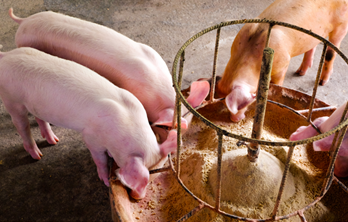Amino Acid Nutrition Update to Ensure Successful Low Protein Diets
2020.03.15

INTRODUCTION
The current level of protein used in livestock diets has produced various issues occurred in the feed industry including feed cost and feed efficiency, health and animal welfare, environmental pollution, and even environment protection tax. More and more people are concentrating on the benefits of low protein diets and making more efforts to get the success of low protein diets with use of feed additives. There are many benefits of low protein diets, such as saving feed cost, increase in feed utilization, i mprovement of body health and animal welfare, and protecting environment. In order to achieve the widespread use of lower protein diets in the feed factory, the use of ideal amino acid ratios with crystalline amino acid supplements will contribute to the investigation of lower protein diets. Supplementation of crystalline essential amino acids such as L-lysine, L-methionine, L-threonine, L-tryptophan, L-valine and L-arginine to balance the digestible amino acids in diets could maintain the performance of livestock fed lower protein diets.
The benefits of low protein diets
Save feed cost
The current CP level used in the feed industry contributes to higher feed cost. As the livestock prices especially pork price decrease sharply, the nutritionists want to save all the unnecessary costs. Therefore, setting-up the real nutritional requirements for animals is necessary. It is very important to evaluate the digestible amino acid contents of raw material. Protein meals contain wide range of AA while crystalline AA are used to meet specific AA requirement of livestock. Soybean meal is the most widely used protein source in the feed industry due to its ideal nutrient characteristics. China had import soybean meal 7.2 Billion MT from U.S., Argentina and Brazil. Digestible AA model to make the formula could save feed cost.
In addition, the increasing availability of specialty feed grade amino acids such as Valine, Tryptophan and Arginine has made lower crude protein diets very easy and feasible.
We talked about decreasing crude protein of diets, not about decreasing the nutrition contents. We just need to make our formula more precise. The ideal protein is the most practical tool to express the amino acid requirements of animals. All ideal amino acids are expressed in ratio to Lys. By formulating each limiting amino acid profile, the protein level will be adjusted automatically with least cost. We had accumulated experience on how to set the Threonine and Methionine ratio to Lysine. The Tryptophan ratio to Lysine has become more and more clearly.
Valine requirement recently updates very quickly. Estimated Val requirements are of 76-80% (SID)Val:Lys depending on the growth performance criteria of broiler, 68-70% (SID) Val:Lys for piglets, and 95-105% (SID)Val:Lys for lactation sow. In terms of Arg, estimated Arg requirements are of 110-115% (SID)Arg:Lys depending on the growth performance criteria of broiler, 100-110% (SID)Arg:Lys for piglets, and 110-120% (SID)Arg:Lys for pregnancy and lactation sow.
In the present situation, if we decrease crude protein level from 22% to 21% in broiler feed and balance the 5th limited amino acid, the feed cost will decrease nearly 2%. A famous enterprise company has been a big success on decrease in crude protein level in pig feeds, it made formula as 12% crude protein level in finishing pig feeds. The company said that this technical method could save 64 RMB/Herd in the feed cost of raising farm.
Increase feed utilization
Excess CP can overload the intestinal tract with excessive undigested protein, and even will cause diarrhea. Excess AAs presented in the diet are absorbed and catabolized, producing higher levels of N excretion in the form of uric acid (Wu, 2013). As undigested proteins exit in the intestine tract and increase the bacterial proliferation, they can cause disease and infection, and will further reduce production performance. Improved feed utilization can be achieved by reducing N retention. Reducing dietary CP can improve N utilization.
Improve livestock health and protect environment Reducing crude protein in diets can decrease the risk of disease and improve animal welfare. N wastes have become a focus of environmental sustainability due to their impacts on water pollution and ecosystems (Sims and wolf, 1994). Reducing dietary CP further promotes the sustainability and marketability of the poultry industry. Improving industry sustainability with low protein diets comes from reducing water intake and N excretion (Belloir et al., 2017).
Belloir P, Meda B, Lambert W, C orrent E, Juin H, Lessire M&Tesseraud S (2017) Animal 11:1881-1889.
Sims JT&Wolf DC (1994) Advances in Agronomy 52:1-83.
Wu G. (2013) Amino acids: Biochemistry and Nutrition:CRC Press























